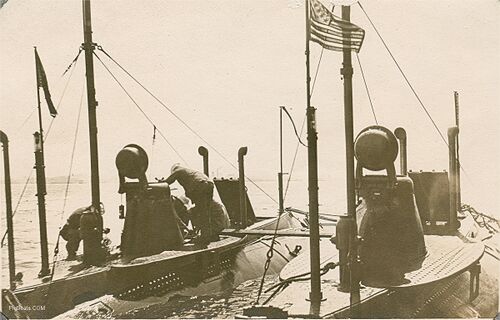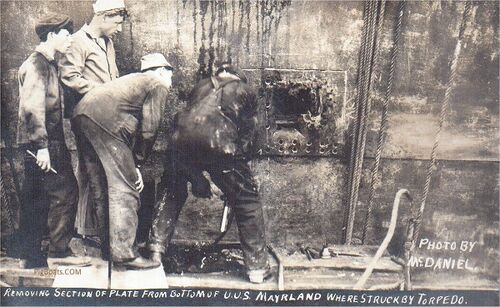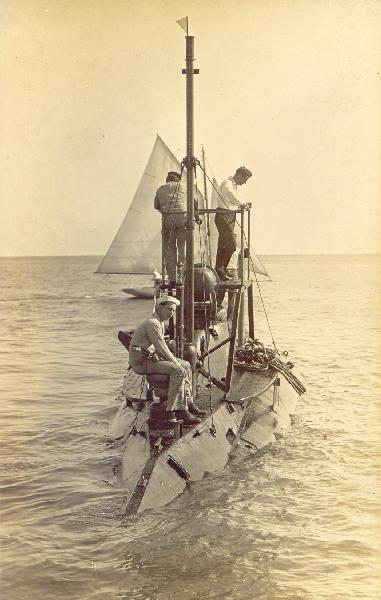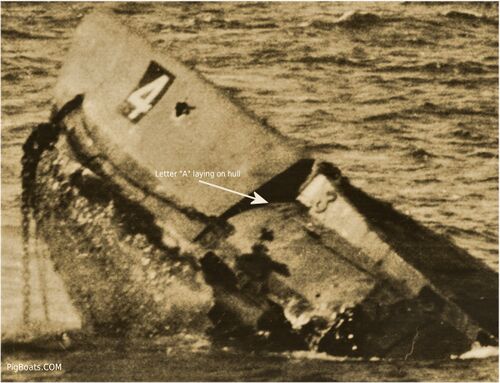A-3

Interesting to note the two electrical wires lead through the after ventilator. If you follow the wires they drape into the water from the dock and up to the ventilator. A very unsafe action especially in these early days of electrical technology. This appears to be an early form of shore power being applied to the submarine for in port use.
At the extreme left of the photo in the background can be seen one of the San Francisco Bay ferries. Not enough detail can be seen to identify it.
An interesting tidbit is that the first commanding officer of Grampus was LT Arthur MacArthur, III, (the older brother of later to be General of the Army Douglas MacArthur of WW II fame), who also was, at the same time, the first commanding officer of the USS Pike (Submarine No. 6). It is seemingly an unusual move to have one man command two boats, but there was a shortage of trained officers at the time.
An original NON-Navy photo in the private collection of Ric Hedman.
It really is a fine piece of craftsmanship and it needs to be in a place where the public can appreciate it.
All photos courtesy of Randle M. Biddle and can not be re-posted without his expressed permission.

Pike, (left) and Grampus, (right), nested together. Location is uncertain but most likely San Francisco area, circa 1905. Note that by the date of this photo Grampus has received a taller conning tower, with a substantial fairwater on the forward and aft sides. The original conning tower (shown in the photos above) proved to be too short. It frequently shipped water when the boat was surfaced even in calm seas.
Four crewmen can be seen on the deck of the Pike working on something that can't be discerned. Note the magnetic compass binnacles mounted aft of the non-retracting periscopes. The compasses were mounted outside the hulls because the steel in the hulls interfered with the compass. They were viewed with mirrors.
The periscopes are braced with guy-wires and did not rotate. The entire boat had to be pointed in the direction that the CO wanted to see. Still, these periscopes were a vast tactical improvement over the previous method of sighting a target, i.e. periodically popping to the surface to sight through the deadlight windows in the conning tower. This "porpoising" maneuver in part gave these boats the nickname "pigboats", as the maneuver reminded contemptuous surface sailors of the actions of porpoises, which old time sailors called "sea-pigs".
Note the open torpedo loading hatches on the bows and the expanded walking deck around the conning tower.
Photo in the private collection of Ric Hedman.

Grampus underway in San Diego Bay with a host of civilian boats, approximately 1905-1910. The Pt. Loma headlands are in the background. Submarines were popular attractions in those days, and in U.S. ports one of them getting underway was sure to generate a lot of interest amongst the local population. Many of them hoped to get a close-up view of the boat diving and surfacing. This was actually a safety issue, as an enthusiastic civilian boater also presented a potential collision hazard for the submarine's crew.
Photo in the private collection of Ric Hedman.

Grampus, aft of the Pike, on the marine railway at Mare Island Navy Yard on February 19, 1908. Work on these submarines (and others) for repair and upkeep was beginning to cause a stir in the House of Representatives. Congressman Lilley of Connecticut was up in arms over the cost of operating and maintaining submarines and was seeking to get the Navy to divulge total costs the government was being asked to pay.
He had stated that the Grampus had cost $33,500 to date (February 1908) and Pike $35,500 in repairs. ($960,000.00 and $1,020,000.00 respectively in 2020 dollars) Part of why he was so upset was that fact much of the costs and reasons for repairs was being kept secret. He demanded to know how efficient the submarines were and what the repair and upkeep time was related to actual time performing their duties.
Seven months later almost to the day, September 19, 1908, while alongside the pier at Mare Island Navy Yard preparing for transport to the Philippines, both submarines would be involved in a devastating gasoline fire that would require several more months of repair work and costing about $20,000 each in further repairs. ($573,000.00 each in 2020 dollars equaling almost $1,146,000.00)
Photo contributed by Darryl Baker and the Vallejo Naval & Historical Museum.

The Grampus and Pike moored to a barge behind the tug USS Fortune. the location is not known but the San Francisco area as well as San Diego are distinct possibilities. Date is circa 1908. Not much detail of the submarines is visible in this photo.
Other photos of the Fortune show her with an after mast that was later removed. A crewman is seen with a hose washing down the topsides.
Photo contributed by David White.

Grampus and Pike moored to a tender in San Diego, CA., approximately 1909-1910. Both boats have their torpedo loading hatches open and have temporary canvas bridge structures installed.
While stationed in San Diego the Grampus was running trials on the bay on December 10, 1910. When returning to the dock the gasoline engine was started. The engine had a faulty intake valve and it exploded injuring three sailors. The most badly injured man was Herman Ley, a Chief Electrician's Mate for the Grampus. Ley had just completed his qualifications in submarine boat work shortly before this accident. The exploding valve hit him in the face breaking his jaw, breaking the bones in his face and fracturing his skull. The other men injured were MM1 John B. Cook (Cooke) who was badly bruised and MM1 Paul H. Moul (Moril) who had been cut and bruised. The men were evacuated to the tender ship Iris for medical treatment. Ley was not expected to live and in fact he passed later that day. Herman William Ley, age 22, was buried at Green Mountain Cemetery, Boulder, Colorado. Section T, row G, Space 32. (Spellings from original newspaper story.)
Life was dangerous aboard these early submarines. Technology was being stretched to the limits.
Photo in the private collection of Ric Hedman.
USS Grampus (Submarine No. 4) crew muster for April 15, 1910. This list is incomplete due to lost records.
| Olding James P. - Ensign age 26 - Born: Nevada |
| Johnstone Harold H. - Midshipman age 23 - Born: Montana |
| Noren Charles E. - CGM age 35 - Born: Sweden |
| Alden Henry C. - CEM age 30 - Born: Ohio |
| Jordan Clyde W. - CMM age 31 - Born: Indiana |
| White Robert J. - GM 1c age 28 - Born: New York |
| Wroughton Edwin R. - QM 1c age 24 - Born: Nebraska |
| Saar Frank A. - MM 1c age 29 - Born: Michigan |
| Moril Paul M. - MM 1c age 25 - Born: Pennsylvania |
| Crofeet William - EM 1c age 25 - Born: New York |
| Cooke John B. - EM 1c age 25 - Born: Arkansas |
| Kuhnen Alexander G. - MM 2c age 25 - Born: Texas |
Thank you to Linda Talbott of the US GenWeb Census Project® for providing this information.

Not a submarine photo, but an interesting one nonetheless. This is the hull of the armored cruiser USS Maryland (ACR-8) showing the hole made by a torpedo fired by the A-3 during exercises that also included the sister boat A-5. The incident happened on August 24, 1912. The submarines were engaged in night maneuvers with the Maryland and were to fire special torpedoes fitted with non-explosive collapsible heads to prevent just such an incident. The torpedo hit the hull nine feet below the waterline and flooded one compartment creating a five degree list to starboard. The Maryland proceeded to Long Beach Harbor and was dry docked where repairs were made.
There was much speculation that the "accident" wasn't an accident and had been created by a faction of Mexicans trying to create an incident to prevent the Maryland from sailing to Mexican waters to remove American nationals from locations on the Mexican shore. These Americans were fleeing unrest and civil war. The suspected Mexicans were supposed to have clandestinely boarded a U.S. support ship and tampered with the torpedoes to be used by the American submarines. By all accounts there was utterly no basis in truth to this wild story.
Photo in the private collection of Ric Hedman.

A-3 seen from the stern, date and location unknown. The man on the aft deck is sitting on the Allied Signal Bell.
Photo in the private collection of Ric Hedman.

The former USS A-3 shown here on or about December 20, 1921 sinking after gun fire hits from several destroyers off of Mariveles Bay, west of Corregidor Island near Manila, in the Philippines. By the date of this photo the hulk of the ex-A-3 was known simply as "Target 4". There are conflicting dates discovered while researching this image.
In the background are the destroyers USS Southard (DD-207) on the left and the Chandler (DD-206) on the right.
The false bow given these early submarines can be clearly seen. Looking closely at the hull, just aft of the false bow the numeral “3” can be seen. This is location where the letter/number names of these submarines were located. The “A” is not seen but the “3” is very visible.
This photo of the A-3 is accompanied by a caption, on the back, stating; “The Talbot sinks a submarine in China Sea.” While it isn’t known for certain that the submarine sunk by Talbot was the ex-A-3 all the logs indicate that Talbot was involved in the circumstances around the sinking of three submarines, ex-A-3 included.
Submarines ex-A-2. ex-A-7, and ex-A-3 were all sunk on December 20, 1921 by destroyers Talbot (DD-114), Zane (DD-337), Roper (DD-147), Waters (DD-115), and Dorsey (DD-117), all of Destroyer Division 12.
Though most submarines sunk during the three day exercise were not named directly in the log books as to who did what, we do know Talbot was responsible for the sinking of the ex-A-6 and at least one other submarine. Ex-A-3?
Photo in the private collection of Ric Hedman.

An extreme close up of the photo above showing ex-A-3 (aka Target 4) as she slides stern first into the waves. We have annotated the image showing what happened to the ex-A-3's name letters. The force of the shells hitting the hull must have sheared off the rusty screws or bolts holding the letter "A". It has dropped onto the pressure hull and lay there as she sank. Only the "3" is still in its original place.
Photo in the private collection of Ric Hedman.
Page created by:
Ric Hedman & David Johnston
1999 - 2023 - PigBoats.COM©
Mountlake Terrace, WA, Norfolk, VA
webmaster at pigboats dot com








